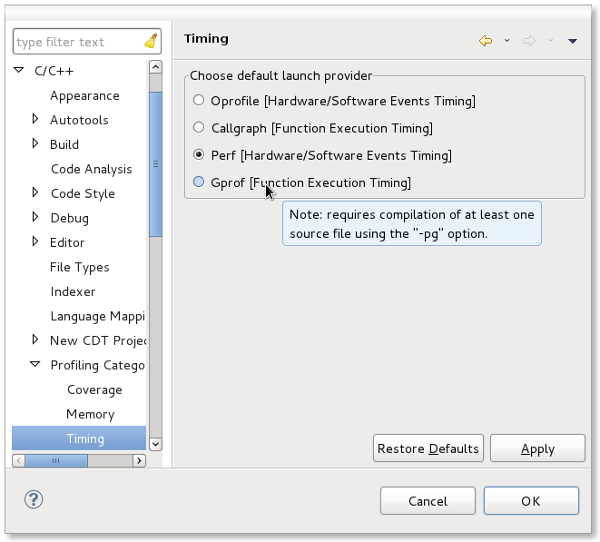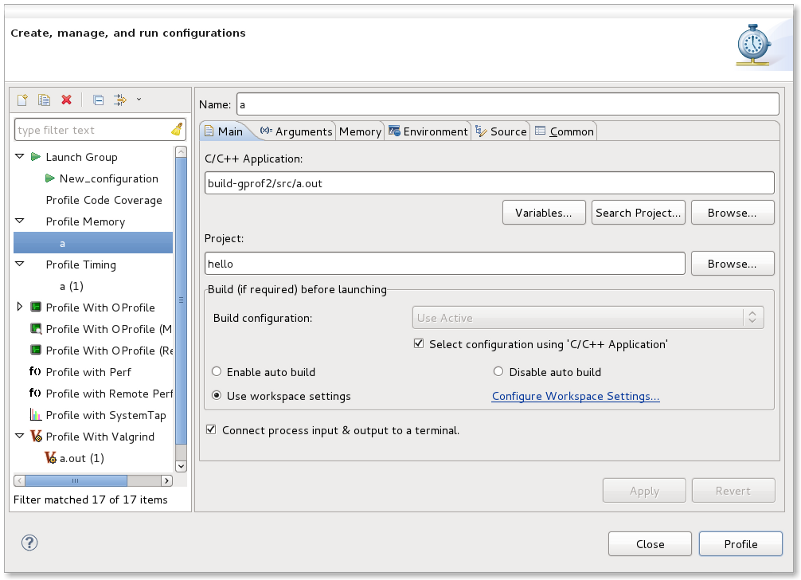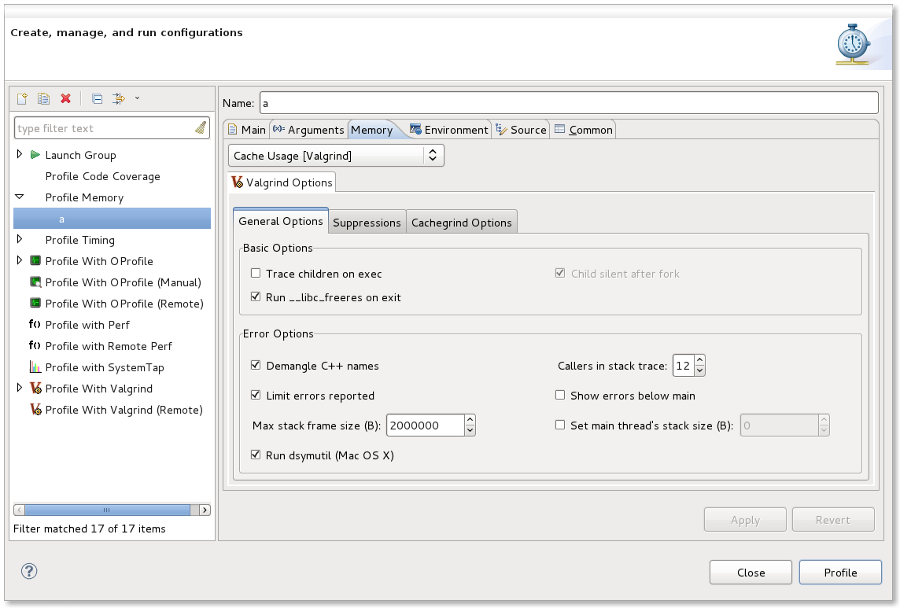Notice: this Wiki will be going read only early in 2024 and edits will no longer be possible. Please see: https://gitlab.eclipse.org/eclipsefdn/helpdesk/-/wikis/Wiki-shutdown-plan for the plan.
Linux Tools Project/Profiling/User Guide
Introduction
The Linux Tools project provides Eclipse interfaces to a number of system tools sufficient to profile a C/C++ application. For example, the Valgrind plug-in provides the ability to profile an application's memory usage while the Perf plug-in allows an end-user to acquire details regarding the amount of time taken in various functions or methods. From the user point-of-view, the user wants to profile a C/C++ executable and this is available via the Profile as.. right-click context menu or via the Profile Configurations... dialog or via the Profile button found next to the Debug and Run buttons at the top of the Eclipse Window.
Support exists for:
- Valgrind (memcheck, massif, cachegrind, and helgrind sub-tools)
- OProfile
- Perf
- SystemTap (using a systemtap script to get call-graph)
- Gcov (code coverage)
- GProf
Profiling Categories
In the past, some of the Linux Tools profiling plug-ins, such as Valgrind, would add a default launch short-cut. The launch short-cut would use a set of default parameters for the profiling tool and would launch the selected executable appropriately. In the case of Valgrind, which supports multiple tools, the short-cut would default one particular tool to use (in Valgrind's case, this is the memcheck tool which checks for memory leaks). In the Eclipse Debug Launch framework, each launch short-cut can specify which mode or modes it applies to (run, debug, and profile). For those short-cuts that specify the profile mode, this results in an added menu entry under the Profile as... context menu. For example, there are short-cuts for Perf, OProfile, and Valgrind which show up as Profile With Perf, Profile With OProfile, and Profile With Valgrind, respectively.
This can be confusing to end-users who are not familiar with the various tools that are out there and what they can do. For example, both OProfile and Perf provide timing results for an application so there is overlap of functionality within the various tools. To alleviate this, the current profiling tools have been grouped into task categories. By default, there are three initial categories:
- Timing - this measure the amount of time taken in functions and methods
- includes Linux Tools Perf, OProfile, Callgraph (via SystemTap), and Gprof
- Memory - this profiles heap/stack/cache usage for an application
- includes Linux Tools Memcheck, Massif, Cachegrind, and Helgrind tools from Valgrind
- Coverage - this measures how much of the code gets exercised in a run
- includes Gcov
For details on using the tools mentioned above, see the appropriate User's Guide for the tool installed from the Linux Tools update site.
The Profiling Category framework is extensible and additional tools such as third-party profiling tools can be added to any of the basic three categories or a new category can be created if needed (e.g. other).
Each category contributes a launch short-cut which results in a menu item under the Profile as... context menu so that an end-user may select to get a timing profile or profile memory usage for a given C/C++ executable. To determine which profiling tool is used from a category short-cut, each tool in a category gives itself a priority so that when multiple tools are installed from the same category, the one with the highest priority becomes the initial default. For example, the Perf tool has the highest priority of the profile timing category tools and so becomes the initial default, if installed. Valgrind memcheck has the highest priority for profiling memory and Gcov is the default for profiling code coverage (at present the only tool in the category).
The default for any category can be directly set/modified by the end-user via Window -> Preferences -> Profiling. Each category of installed tools using the framework will present a sub-page within the Profiling Preferences category. The preferences page for the category will display a radio button for each tool that is installed, belonging to that particular category. If no tools are installed for a given category, no preferences page is displayed. If the user has not set a preferred tool for a category, the priority of each installed tool will determine the default.
The following shows the Profiling Preferences page for the Timing Category whereby the Linux Tools Perf, OProfile, and Callgraph plug-ins are installed. Note the Perf tool being the default:

Profiling Configurations
As mentioned, each short-cut creates a menu item under the Profile as... context menu (e.g. right-click on a C/C++ executable). In addition to the short-cuts for each category, the end-user may select Profile Configurations...
This brings up a dialog that allows the user to modify current launch configurations or to create new ones:
The following tabs are provided in all Linux Tools profiling configurations:
- Main
- This tab allows one to set the C/C++ executable and Eclipse project.
- Arguments
- This tab sets the arguments to pass to the C/C++ program when profiling it.
- Environment
- This tab sets any environment variables to set when running the program and profiling. You can choose to override the current environment or to replace it entirely.
- Source
- This tab sets the source lookup path which may be used by the Linux Tools Profiling plug-ins to open source code via the UI.
- Common
- This tab allows one to specify how the configuration gets stored, mark it as a favorite Profiling configuration, and to set up a console in the case where C/C++ standard input/output is used.
In addition to the common tabs, each category contributes a tab for its own settings. For example, for Profile Memory, there is a Memory tab added:
When you choose a short-cut from the Profile as... context menu (e.g. Profile Memory),
a launch configuration will be created for you, if one does not currently exist for the C/C++ executable that is chosen. If there are multiple configurations with different names that
point to the same executable, a dialog will be offered to you to select which profile you wish to use.
The executable will be the one you right-clicked on and the project will be set to its
project automatically. With all short-cuts, a set of default parameters are set up for you.
If you wish to create a new configuration from scratch, simply select the type of profiling launch configuration you wish to create by clicking in the left-hand tree view and
then push the LinuxToolsProfilingNewIcon.png icon. When a new configuration is created this way, one needs to specify the executable, project, etc... manually.


